Abstract
1. Single fusimotor fibres to de-efferented soleus of the cat were stimulated to investigate the size and time course of the responses elicited in single primary spindle afferents. The muscle was kept at constant length close to the physiological maximum. Constant and alternating rates of fusimotor stimulation were used: (a) repetitive stimulation at constant rate (maintained stimulation); (b) modulated stimulation with the rate of activation alternating between two constant levels at repeat frequencies between 0.09 and 2 Hz (rectangular stimulation). The responses were averaged and displayed as post-stimulus time (pst) histograms (a) or as cycle histograms (b). 2. During static fusimotor stimulation the pst histograms could be clearly modulated over a range of rates of stimulation. However, histogram modulation was not a prerequisite of static action since with different fibres the degree of modulation could range from deeply modulated to completely non-modulated to completely non-modulated. 3. Dynamic fusimotor stimulation was almost always accompanied by non-modulated pst histograms. 4. Primary spindle afferents responded to rectangular stimulation of either kind of fusimotor fibre with an approximately rectangular modulation of the rate of discharge. At the repeat frequencies studied the size of the responses was appreciably larger with static than with dynamic activation. It was assessed as 'fusimotor rate-sensitivity during alternating stimulation' by the response/stimulus ratio which is defined as change in firing/change in alternating rate of stimulation, in impulses/stimuli. The mean values of rate-sensitivity were 1.35 impulses/stimuli (statics) and 0.29 (dynamics), with a static/dynamic ratio of 4.7. 5. The afferents' 'fusimotor rate-sensitivity during steady stimulation' (change in firing/change in maintained rate of stimulation( was also determined. The mean values were 0.78 (static) and 0.37 (dynamics), with a static/dynamic ratio of 2.1. 6. The time course of the responses to rectangular stimulation was of the same order of magnitude for static and dynamic fibres. It was assessed by fitting a single exponential to the rising and falling phase of cycle histograms. The mean values of the time constants for static fibres were 58 msec (rising phase) and 59 msec (falling phase), and for dynamic fibres 34 msec (rising phase) and 49 msec (falling phase). The differences were statistically non-significant. 7. The significance of the modulation in pst histograms and the mechanisms and functional implications of the differences in rate-sensitivity are discussed. It is concluded that at constant muscle length static and dynamic fusimotor fibres differ significantly by the size rather than the speed of their action on primary spindle afferents.
Full text
PDF
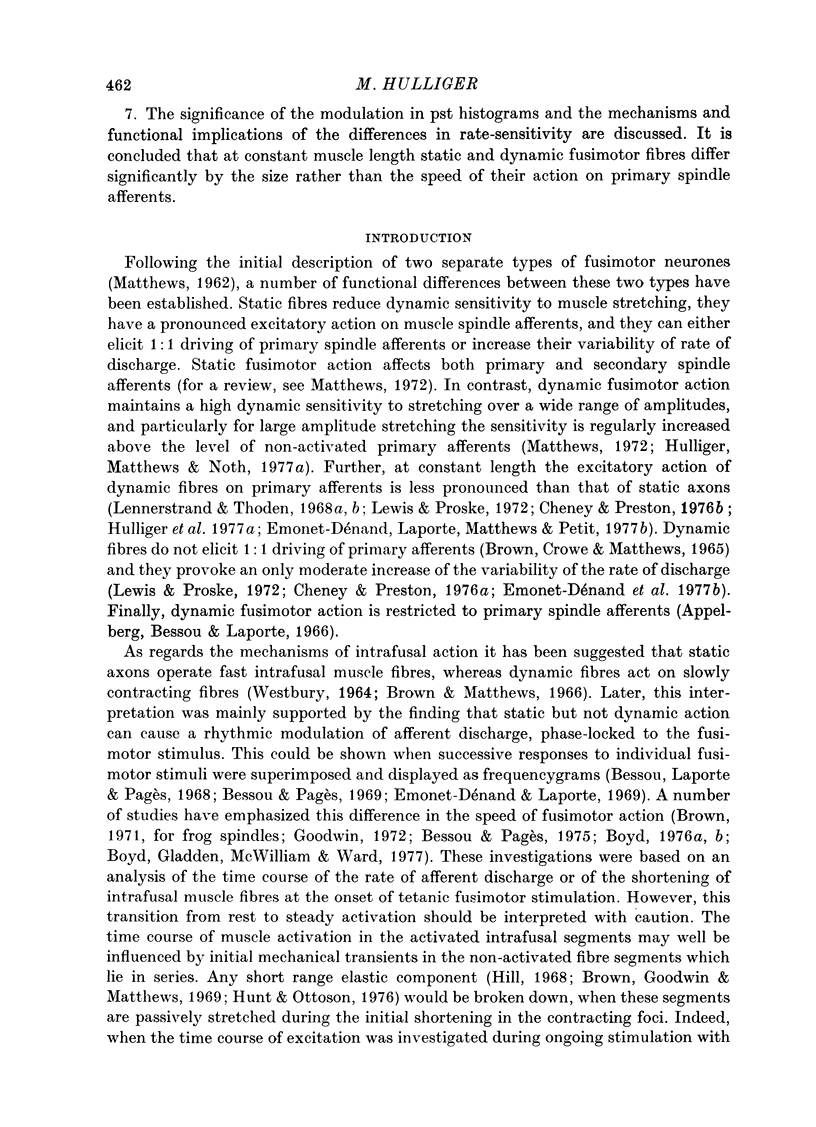
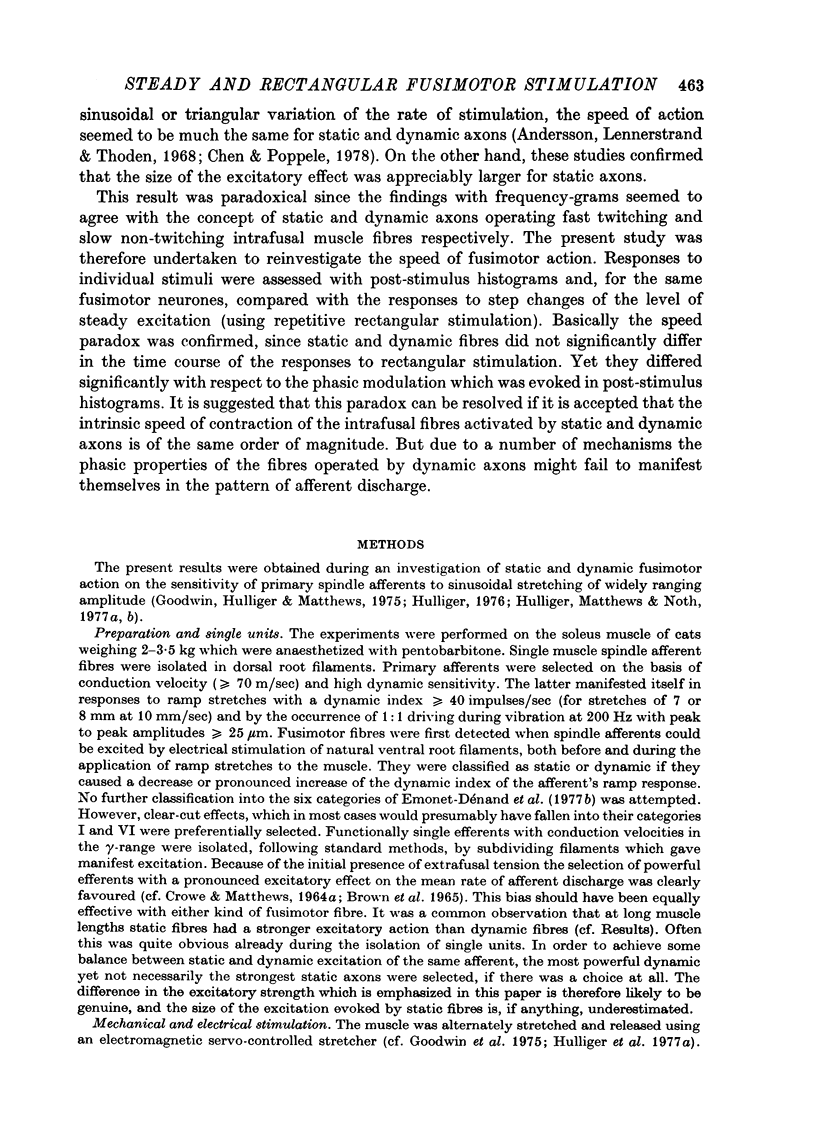
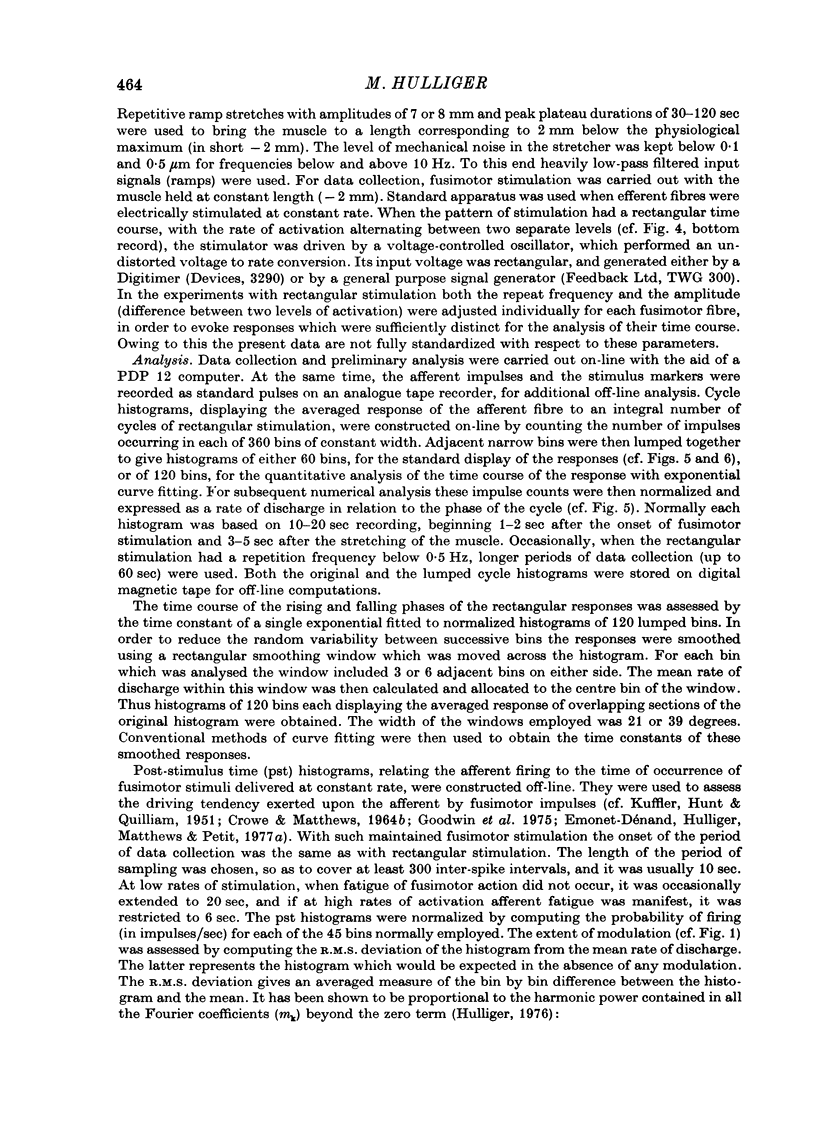
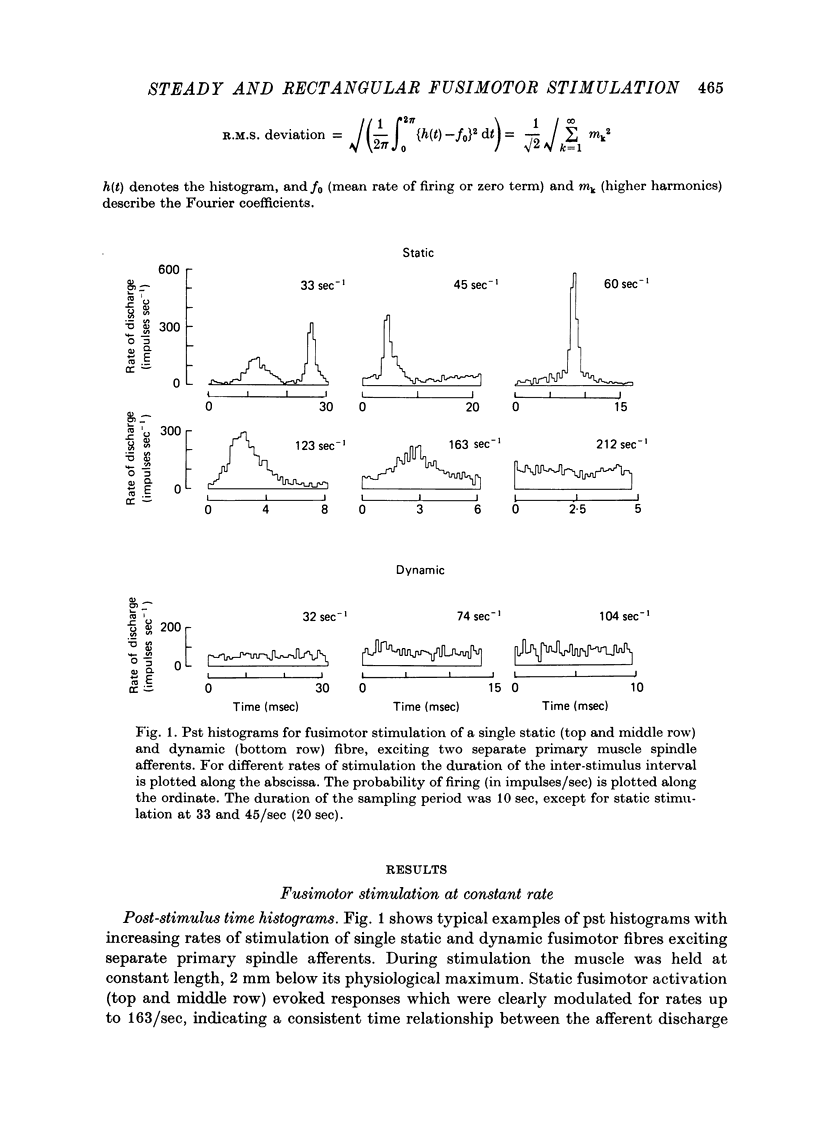

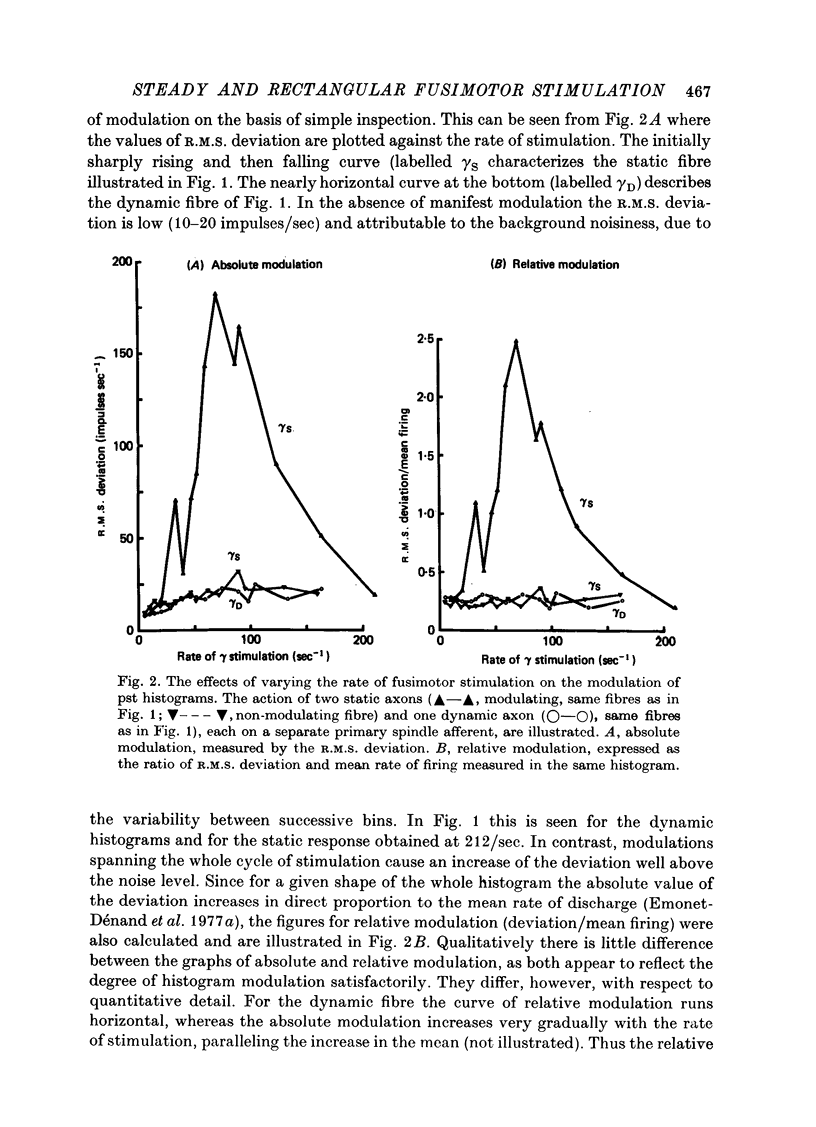
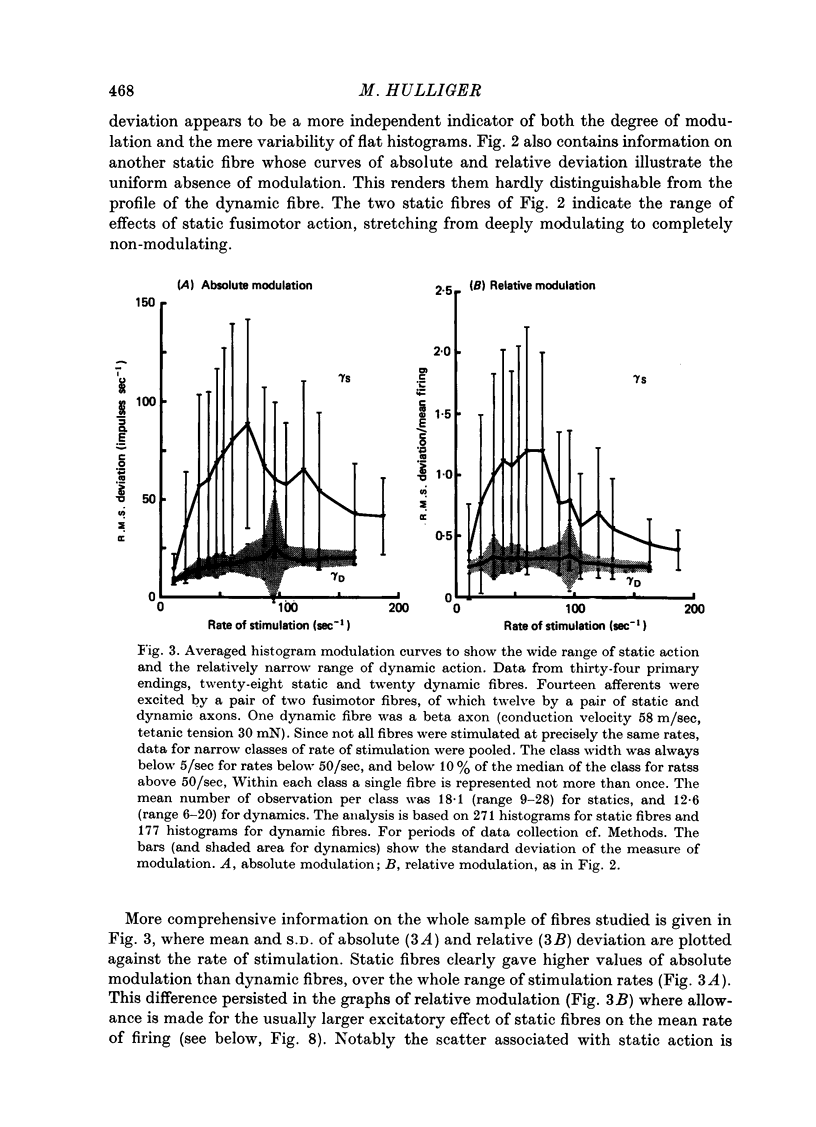
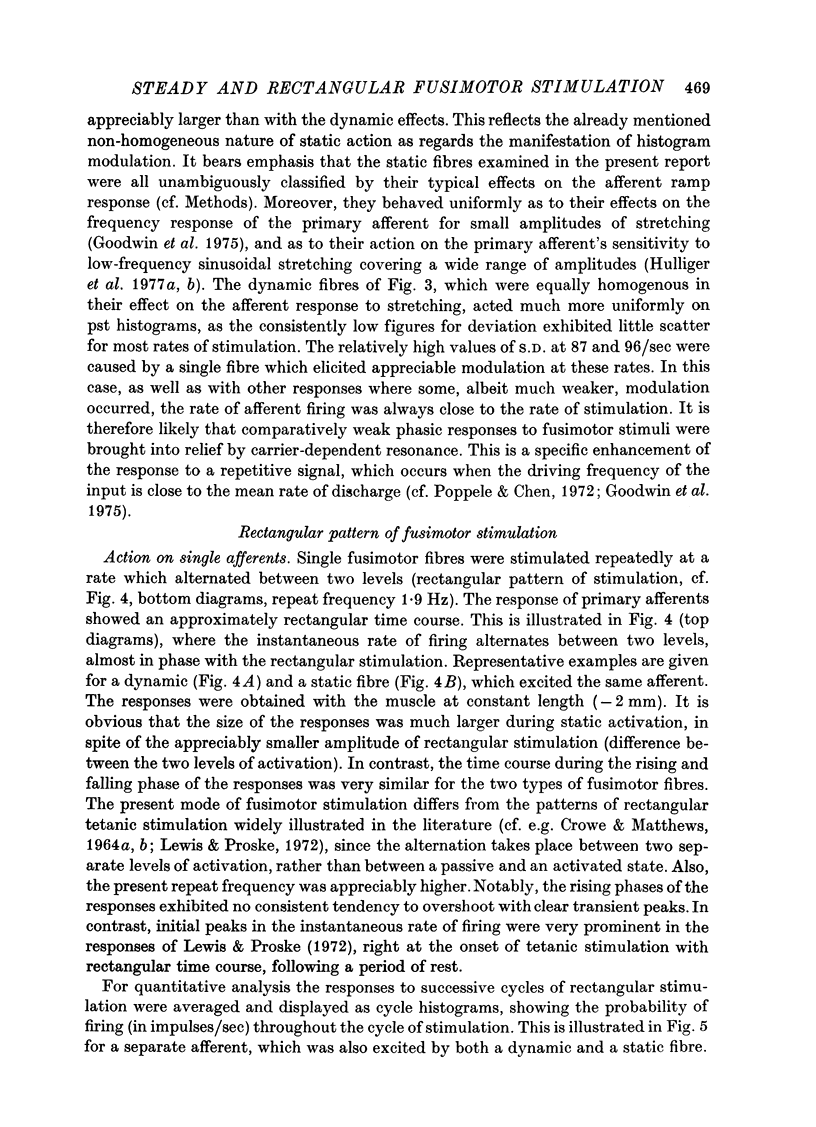

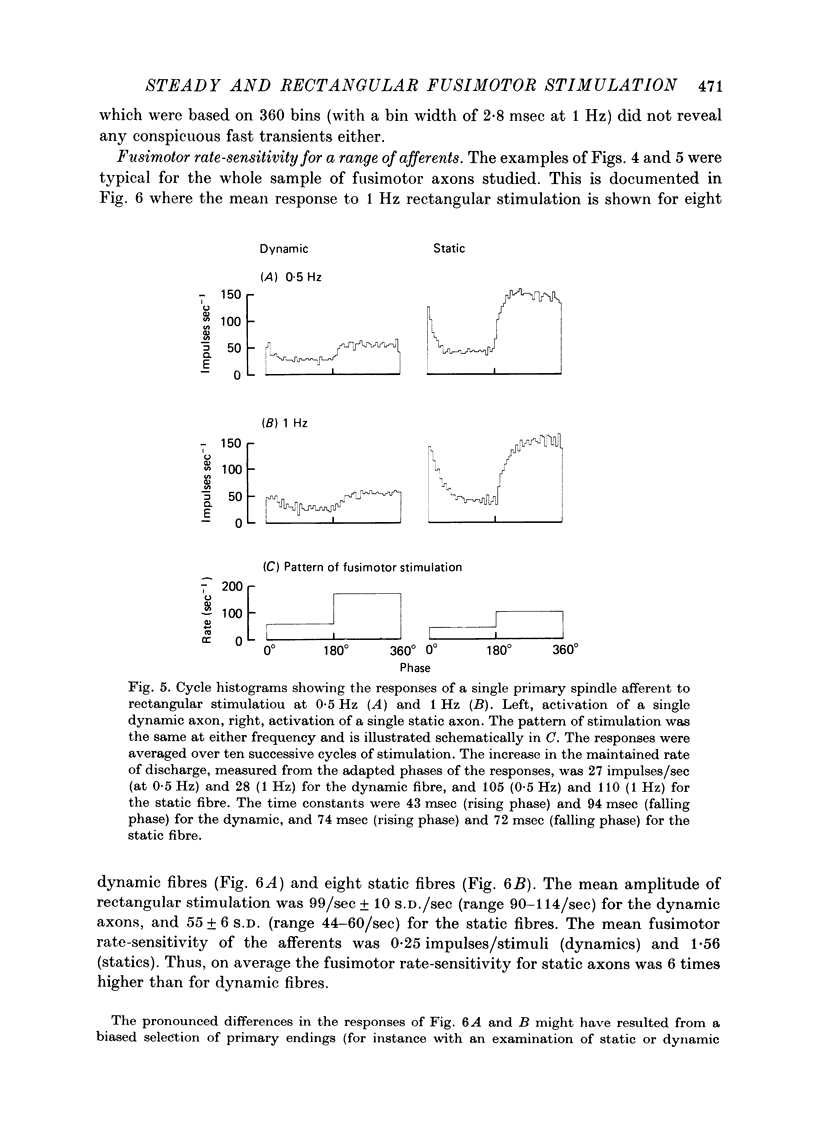

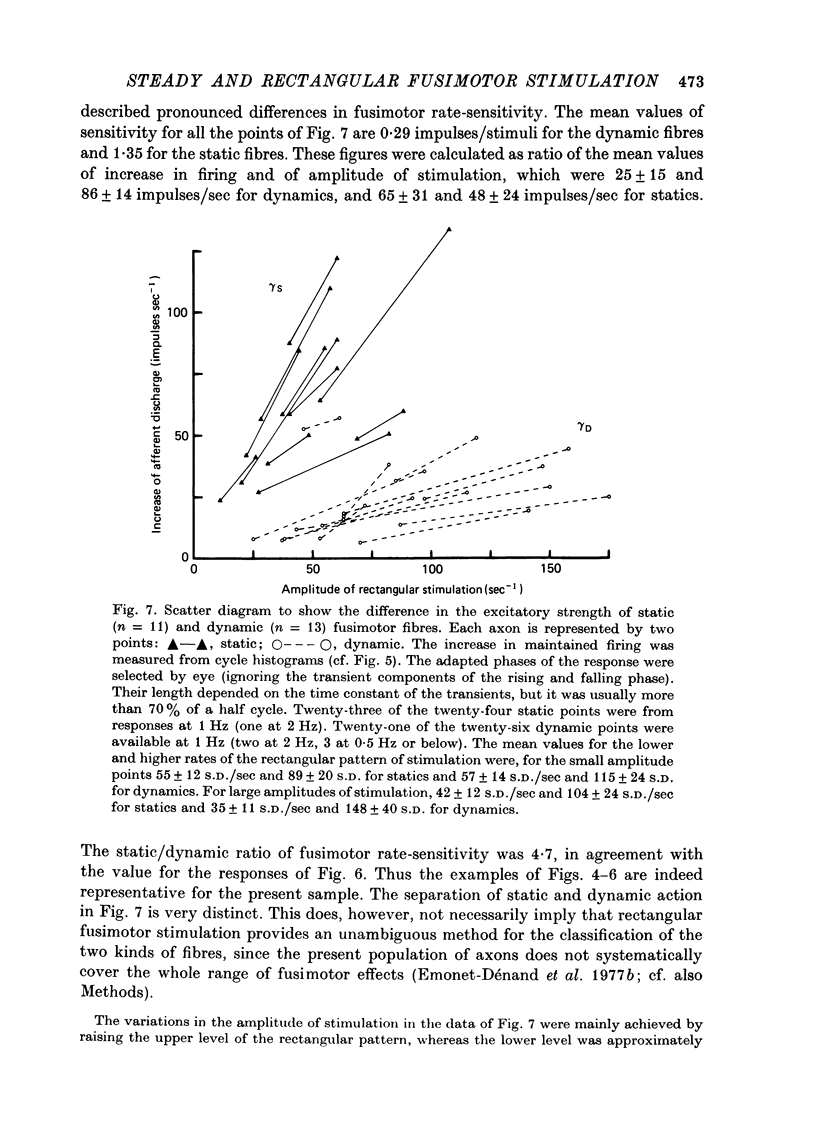
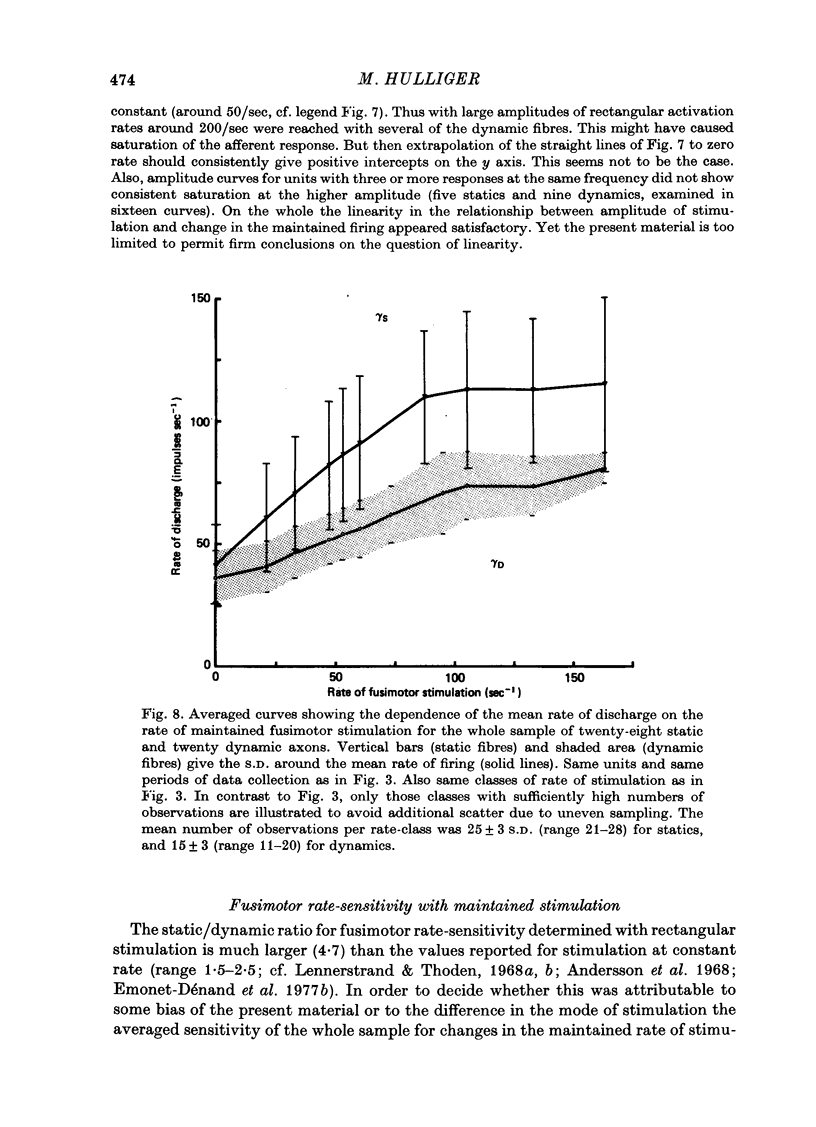

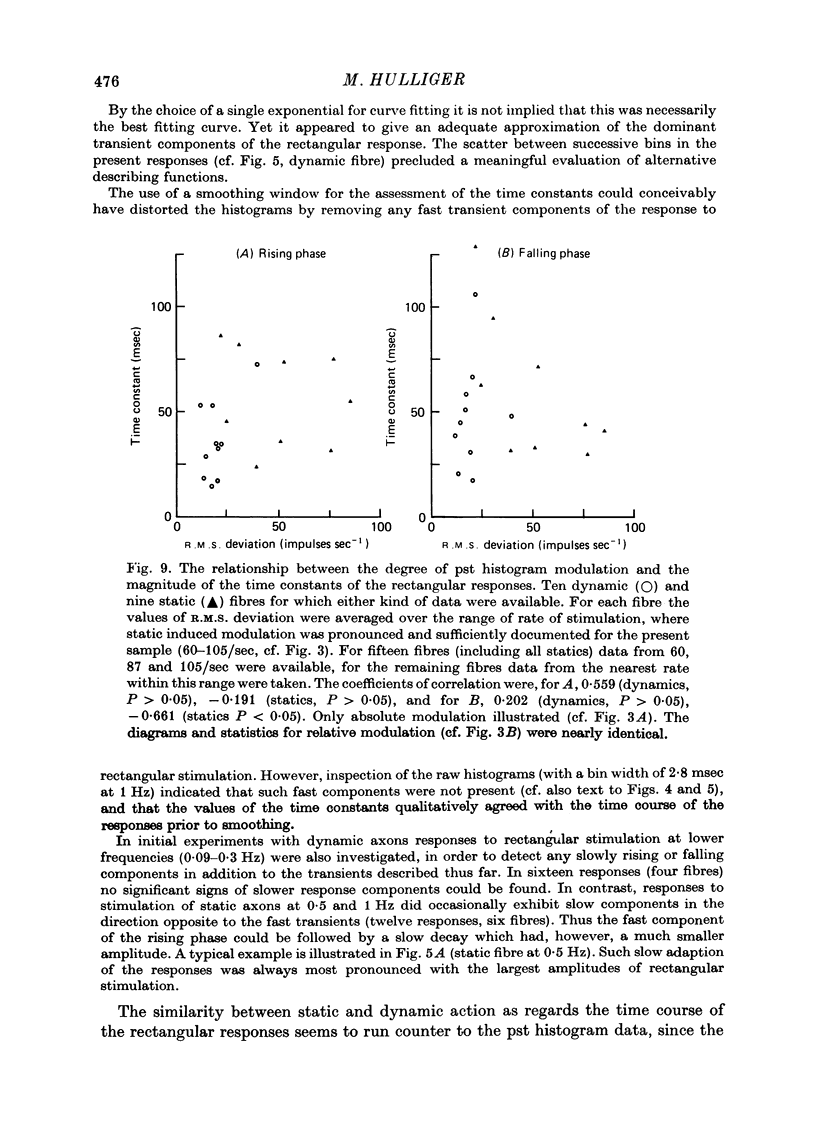

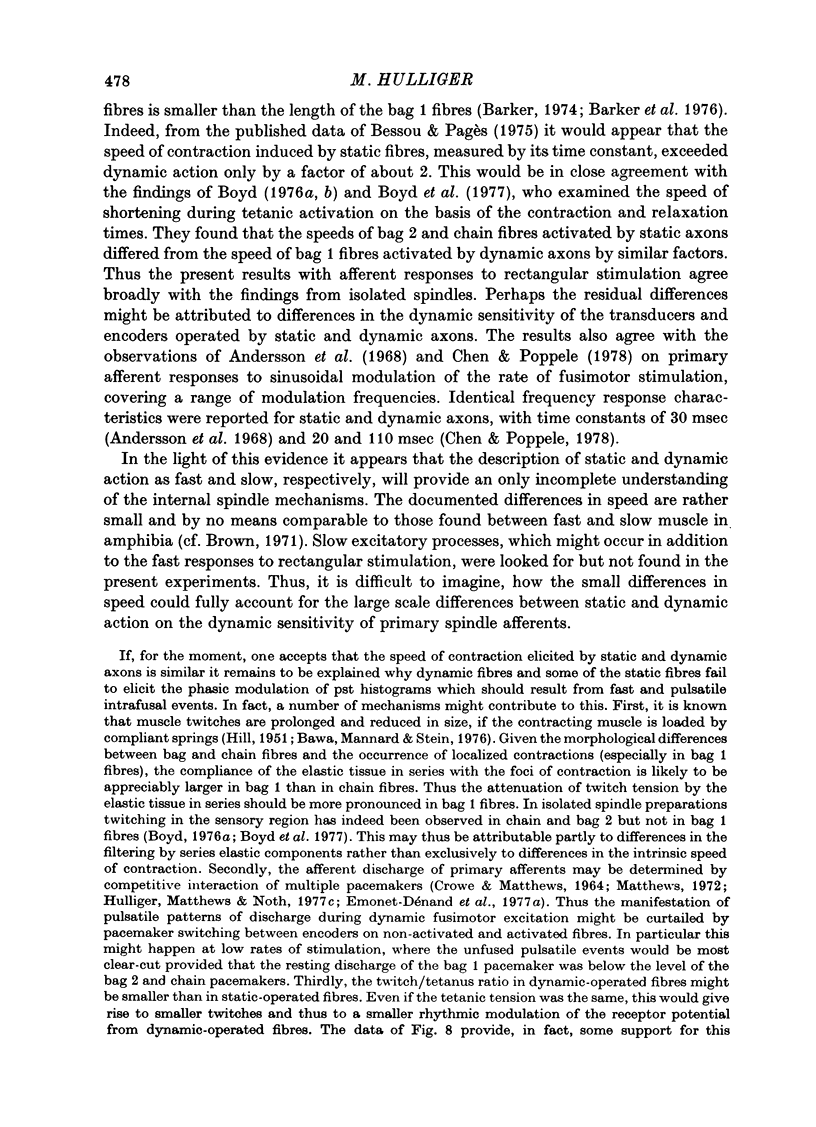


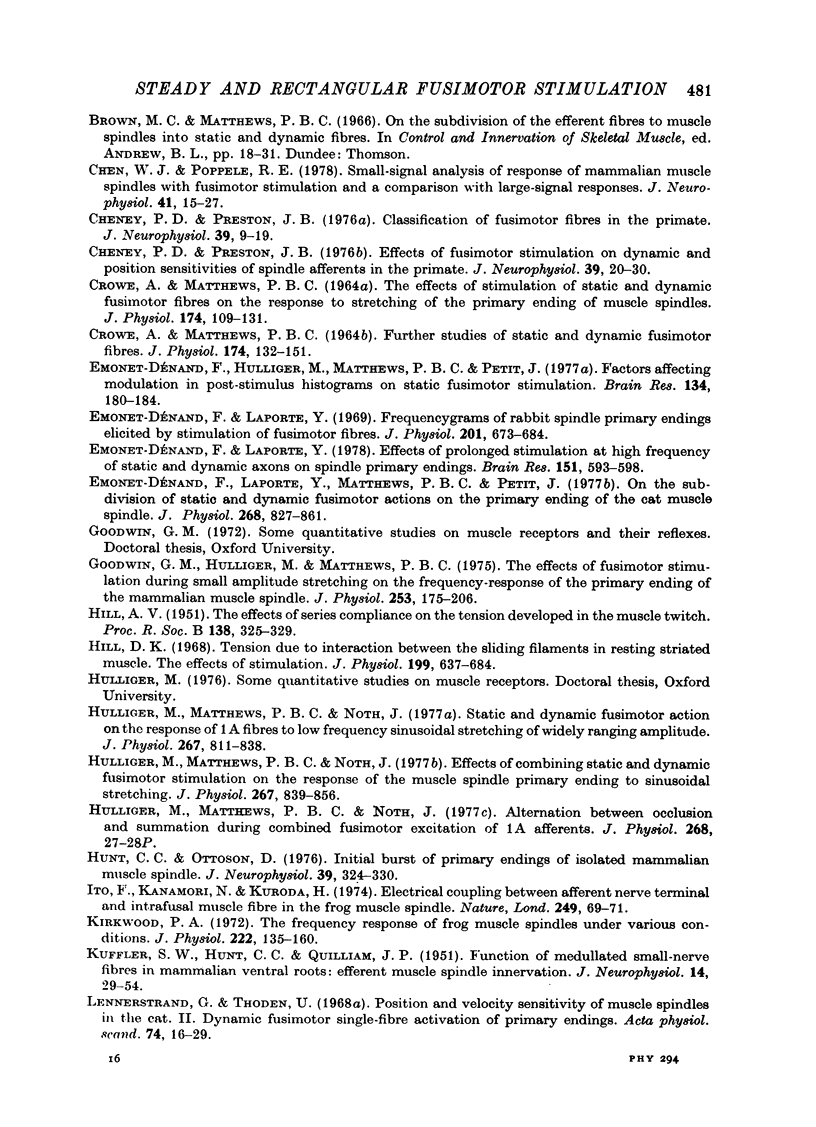

Images in this article
Selected References
These references are in PubMed. This may not be the complete list of references from this article.
- Andersson B. F., Lennerstrand G., Thoden U. Response characteristics of muscle spindle endings at constant length to variations in fusimotor activation. Acta Physiol Scand. 1968 Nov;74(3):301–318. doi: 10.1111/j.1748-1716.1968.tb04238.x. [DOI] [PubMed] [Google Scholar]
- Appelberg B., Bessou P., Laporte Y. Action of static and dynamic fusimotor fibres on secondary endings of cat's spindles. J Physiol. 1966 Jul;185(1):160–171. doi: 10.1113/jphysiol.1966.sp007978. [DOI] [PMC free article] [PubMed] [Google Scholar]
- BROWN M. C., CROWE A., MATTHEWS P. B. OBSERVATIONS ON THE FUSIMOTOR FIBRES OF THE TIBIALIS POSTERIOR MUSCLE OF THE CAT. J Physiol. 1965 Mar;177:140–159. doi: 10.1113/jphysiol.1965.sp007582. [DOI] [PMC free article] [PubMed] [Google Scholar]
- Barker D., Emonet-Dénand F., Harker D. W., Jami L., Laporte Y. Distribution of fusimotor axons to intrafusal muscle fibres in cat tenuissimus spindles as determined by the glycogen-depletion method. J Physiol. 1976 Sep;261(1):49–69. doi: 10.1113/jphysiol.1976.sp011548. [DOI] [PMC free article] [PubMed] [Google Scholar]
- Bawa P., Mannard A., Stein R. B. Effects of elastic loads on the contractions of cat muscles. Biol Cybern. 1976;22(3):129–137. doi: 10.1007/BF00365523. [DOI] [PubMed] [Google Scholar]
- Bessou P., Laporte Y., Pagès B. Frequencygrams of spindle primary endings elicited by stimulation of static and dynamic fusimotor fibres. J Physiol. 1968 May;196(1):47–63. doi: 10.1113/jphysiol.1968.sp008493. [DOI] [PMC free article] [PubMed] [Google Scholar]
- Bessou P., Pagès B. Intracellular potentials from intrafusal muscle fibers evoked by stimulation of static and dynamic fusimotor axons in the cat. J Physiol. 1972 Dec;227(3):709–727. doi: 10.1113/jphysiol.1972.sp010055. [DOI] [PMC free article] [PubMed] [Google Scholar]
- Bessou P., Pagès B. Spindle secondary ending responses elicited by stimulation of static fusimotor axons. J Physiol. 1969 Jun;202(3):569–584. doi: 10.1113/jphysiol.1969.sp008828. [DOI] [PMC free article] [PubMed] [Google Scholar]
- Bessou P., Pagés B. Cinematographic analysis of contractile events produced in intrafusal muscle fibres by stimulation of static and dynamic fusimotor axons. J Physiol. 1975 Nov;252(2):397–427. doi: 10.1113/jphysiol.1975.sp011150. [DOI] [PMC free article] [PubMed] [Google Scholar]
- Boyd I. A., Gladden M. H., McWilliam P. N., Ward J. Control of dynamic and static nuclear bag fibres and nuclear chain fibres by gamma and beta axons in isolated cat muscle spindels. J Physiol. 1977 Feb;265(1):133–162. doi: 10.1113/jphysiol.1977.sp011709. [DOI] [PMC free article] [PubMed] [Google Scholar]
- Boyd I. A. The mechanical properties of dynamic nuclear bag fibres, static nuclear bag fibres and nuclear chain fibres in isolated cat muscle spindles. Prog Brain Res. 1976;44:33–50. [PubMed] [Google Scholar]
- Boyd I. A. The response of fast and slow nuclear bag fibres and nuclear chain fibres in isolated cat muscle spindles to fusimotor stimulation, and the effect of intrafusal contraction on the sensory endings. Q J Exp Physiol Cogn Med Sci. 1976 Jul;61(3):203–254. doi: 10.1113/expphysiol.1976.sp002354. [DOI] [PubMed] [Google Scholar]
- Brown M. C., Butler R. G. An investigation into the site of termination of static gamma fibres within muscle spindles of the cat peroneus longus muscle. J Physiol. 1975 May;247(1):131–143. doi: 10.1113/jphysiol.1975.sp010924. [DOI] [PMC free article] [PubMed] [Google Scholar]
- Brown M. C., Butler R. G. Studies on the site of termination of static and dynamic fusimotor fibres within muscle spindles of the tenuissimus muscle of the cat. J Physiol. 1973 Sep;233(3):553–573. doi: 10.1113/jphysiol.1973.sp010323. [DOI] [PMC free article] [PubMed] [Google Scholar]
- Brown M. C., Goodwin G. M., Matthews P. B. After-effects of fusimotor stimulation on the response of muscle spindle primary afferent endings. J Physiol. 1969 Dec;205(3):677–694. doi: 10.1113/jphysiol.1969.sp008990. [DOI] [PMC free article] [PubMed] [Google Scholar]
- Brown M. C. The responses of frog muscle spindles and fast and slow muscle fibres to a variety of mechanical inputs. J Physiol. 1971 Oct;218(1):1–17. doi: 10.1113/jphysiol.1971.sp009601. [DOI] [PMC free article] [PubMed] [Google Scholar]
- CROWE A., MATTHEWS P. B. FURTHER STUDIES OF STATIC AND DYNAMIC FUSIMOTOR FIBRES. J Physiol. 1964 Oct;174:132–151. doi: 10.1113/jphysiol.1964.sp007477. [DOI] [PMC free article] [PubMed] [Google Scholar]
- CROWE A., MATTHEWS P. B. THE EFFECTS OF STIMULATION OF STATIC AND DYNAMIC FUSIMOTOR FIBRES ON THE RESPONSE TO STRETCHING OF THE PRIMARY ENDINGS OF MUSCLE SPINDLES. J Physiol. 1964 Oct;174:109–131. doi: 10.1113/jphysiol.1964.sp007476. [DOI] [PMC free article] [PubMed] [Google Scholar]
- Chen W. J., Poppele R. E. Small-signal analysis of response of mammalian muscle spindles with fusimotor stimulation and a comparison with large-signal responses. J Neurophysiol. 1978 Jan;41(1):15–27. doi: 10.1152/jn.1978.41.1.15. [DOI] [PubMed] [Google Scholar]
- Cheney P. D., Preston J. B. Classification of fusimotor fibers in the primate. J Neurophysiol. 1976 Jan;39(1):9–19. doi: 10.1152/jn.1976.39.1.9. [DOI] [PubMed] [Google Scholar]
- Cheney P. D., Preston J. B. Effects of fusimotor stimulation on dynamic and position sensitivities of spindle afferents in the primate. J Neurophysiol. 1976 Jan;39(1):20–30. doi: 10.1152/jn.1976.39.1.20. [DOI] [PubMed] [Google Scholar]
- Emonet-Dénand F., Hulliger M., Matthews P. B., Petit J. Factors affecting modulation in post-stimulus histograms on static fusimotor stimulation. Brain Res. 1977 Sep 23;134(1):180–184. doi: 10.1016/0006-8993(77)90938-6. [DOI] [PubMed] [Google Scholar]
- Emonet-Dénand F., Laporte Y. Effects of prolonged stimulation at high frequency of static and dynamic gamma axons on spindle primary endings. Brain Res. 1978 Aug 11;151(3):593–598. doi: 10.1016/0006-8993(78)91092-2. [DOI] [PubMed] [Google Scholar]
- Emonet-Dénand F., Laporte Y. Frequencygrams of rabbit spindle primary endings elicited by stimulation of fusimotor fibres. J Physiol. 1969 May;201(3):673–684. doi: 10.1113/jphysiol.1969.sp008780. [DOI] [PMC free article] [PubMed] [Google Scholar]
- Emonet-Dénand F., Laporte Y., Matthews P. B., Petit J. On the subdivision of static and dynamic fusimotor actions on the primary ending of the cat muscle spindle. J Physiol. 1977 Jul;268(3):827–861. doi: 10.1113/jphysiol.1977.sp011884. [DOI] [PMC free article] [PubMed] [Google Scholar]
- Goodwin G. M., Hulliger M., Matthews P. B. The effects of fusimotor stimulation during small amplitude stretching on the frequency-response of the primary ending of the mammalian muscle spindle. J Physiol. 1975 Dec;253(1):175–206. doi: 10.1113/jphysiol.1975.sp011186. [DOI] [PMC free article] [PubMed] [Google Scholar]
- Hill D. K. Tension due to interaction between the sliding filaments in resting striated muscle. The effect of stimulation. J Physiol. 1968 Dec;199(3):637–684. doi: 10.1113/jphysiol.1968.sp008672. [DOI] [PMC free article] [PubMed] [Google Scholar]
- Hulliger M., Matthews P. B., Noth J. Alternation between occlusion and summation during combined fusimotor excitation of Ia afferents [proceedings]. J Physiol. 1977 Jun;268(1):27P–28P. [PubMed] [Google Scholar]
- Hulliger M., Matthews P. B., Noth J. Effects of combining static and dynamic fusimotor stimulation on the response of the muscle spindle primary ending to sinusoidal stretching. J Physiol. 1977 Jun;267(3):839–856. doi: 10.1113/jphysiol.1977.sp011840. [DOI] [PMC free article] [PubMed] [Google Scholar]
- Hulliger M., Matthews P. B., Noth J. Static and dynamic fusimotor action on the response of Ia fibres to low frequency sinusoidal stretching of widely ranging amplitude. J Physiol. 1977 Jun;267(3):811–838. doi: 10.1113/jphysiol.1977.sp011839. [DOI] [PMC free article] [PubMed] [Google Scholar]
- Hunt C. C., Ottoson D. Initial burst of primary endings of isolated mammalian muscle spindles. J Neurophysiol. 1976 Mar;39(2):324–330. doi: 10.1152/jn.1976.39.2.324. [DOI] [PubMed] [Google Scholar]
- Ito F., Kanamori N., Kuroda H. Electrical coupling between afferent nerve terminal and intrafusal muscle fibre in the frog muscle spindle. Nature. 1974 May 3;249(452):69–71. doi: 10.1038/249069a0. [DOI] [PubMed] [Google Scholar]
- KUFFLER S. W., HUNT C. C., QUILLIAM J. P. Function of medullated small-nerve fibers in mammalian ventral roots; efferent muscle spindle innervation. J Neurophysiol. 1951 Jan;14(1):29–54. doi: 10.1152/jn.1951.14.1.29. [DOI] [PubMed] [Google Scholar]
- Kirkwood P. A. The frequency response of frog muscle spindles under various conditions. J Physiol. 1972 Apr;222(1):135–160. doi: 10.1113/jphysiol.1972.sp009791. [DOI] [PMC free article] [PubMed] [Google Scholar]
- Lennerstrand G., Thoden U. Position and velocity sensitivity of muscle spindles in the cat. 3. Static fusimotor single-fibre activation of primary and secondary endings. Acta Physiol Scand. 1968 Sep-Oct;74(1):30–49. doi: 10.1111/j.1748-1716.1968.tb04212.x. [DOI] [PubMed] [Google Scholar]
- Lennerstrand G., Thoden U. Position and velocity sensitivity of muscle spindles in the cat. II. Dynamic fusimotor single-fibre activation of primary endings. Acta Physiol Scand. 1968 Sep-Oct;74(1):16–29. doi: 10.1111/j.1748-1716.1968.tb04211.x. [DOI] [PubMed] [Google Scholar]
- Lewis D. M., Proske U. The effect of muscle length and rate of fusimotor stimulation on the frequency of discharge in primary endings from muscle spindles in the cat. J Physiol. 1972 May;222(3):511–535. doi: 10.1113/jphysiol.1972.sp009812. [DOI] [PMC free article] [PubMed] [Google Scholar]
- Poppele R. E., Bowman R. J. Quantitative description of linear behavior of mammalian muscle spindles. J Neurophysiol. 1970 Jan;33(1):59–72. doi: 10.1152/jn.1970.33.1.59. [DOI] [PubMed] [Google Scholar]
- Smith R. S., Koles Z. J. Mechanical properties of muscle spindles in Xenopus laevis. Kybernetik. 1974 Jun 21;15(2):91–98. doi: 10.1007/BF00270653. [DOI] [PubMed] [Google Scholar]



